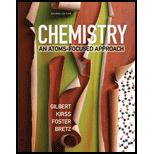
To calculate:
The
Answer to Problem 16.123QA
Solution:
a) pH at the equivalence point of titration of formic acid is 8.23.
b) pH at the equivalence point of titration of boric acid is 10.98.
c) Considering the difference in the pH values at equivalence point, the same indicator should not be used for both titrations.
Explanation of Solution
1) Concept:
We are asked to find the =
Formic acid is a weak organic monoprotic acid with the
Boric acid is a weak monobasic acid. For the titration between boric acid and
2) Formulae:
i)
ii)
iii)
iv)
v)
vi)
3) Given:
i) Volume of formic acid
ii) Molarity of formic acid
iii)
iv) Volume of boric acid
v) Molarity of boric acid
vi) Molarity of
vii)
4) Calculations:
a) Calculating the
Calculating moles of formic acid using given molarity and volume:
At the equivalence point, moles of formic acid and sodium hydroxide are equal. Thus, moles of
Calculating the volume of
Total volume of solution is
At the equivalence point, moles of sodium formate formed are
At the equivalence point, salt sodium formate
Creating an ICE table for the dissociation reaction of sodium formate as
| Initial | |||
| Change | |||
| Equilibrium | |||
Writing the
The
Indicator changes color over a
b) Calculating the
Calculating moles of boric acid using given molarity and volume. Here, we assume that the volume of boric acid is
At the equivalence point, moles of formic acid and sodium hydroxide are equal. Thus, moles of
Calculating volume of
Total volume of solution is
During the reaction of boric acid and sodium hydroxide, sodium borate will be produced. At the equivalence point, moles of sodium borate formed are
At the equivalence point, salt sodium borate
Creating an RICE table for the dissociation reaction of sodium borate as:
| Initial | |||
| Change | |||
| Equilibrium | |||
Writing the
The
Indicator changes color over a
Conclusion:
Indicator changes color over a
Want to see more full solutions like this?
Chapter 16 Solutions
CHEMISTRY:ATOMS-FOCUSED..-ACCESS
 ChemistryChemistryISBN:9781305957404Author:Steven S. Zumdahl, Susan A. Zumdahl, Donald J. DeCostePublisher:Cengage Learning
ChemistryChemistryISBN:9781305957404Author:Steven S. Zumdahl, Susan A. Zumdahl, Donald J. DeCostePublisher:Cengage Learning ChemistryChemistryISBN:9781259911156Author:Raymond Chang Dr., Jason Overby ProfessorPublisher:McGraw-Hill Education
ChemistryChemistryISBN:9781259911156Author:Raymond Chang Dr., Jason Overby ProfessorPublisher:McGraw-Hill Education Principles of Instrumental AnalysisChemistryISBN:9781305577213Author:Douglas A. Skoog, F. James Holler, Stanley R. CrouchPublisher:Cengage Learning
Principles of Instrumental AnalysisChemistryISBN:9781305577213Author:Douglas A. Skoog, F. James Holler, Stanley R. CrouchPublisher:Cengage Learning Organic ChemistryChemistryISBN:9780078021558Author:Janice Gorzynski Smith Dr.Publisher:McGraw-Hill Education
Organic ChemistryChemistryISBN:9780078021558Author:Janice Gorzynski Smith Dr.Publisher:McGraw-Hill Education Chemistry: Principles and ReactionsChemistryISBN:9781305079373Author:William L. Masterton, Cecile N. HurleyPublisher:Cengage Learning
Chemistry: Principles and ReactionsChemistryISBN:9781305079373Author:William L. Masterton, Cecile N. HurleyPublisher:Cengage Learning Elementary Principles of Chemical Processes, Bind...ChemistryISBN:9781118431221Author:Richard M. Felder, Ronald W. Rousseau, Lisa G. BullardPublisher:WILEY
Elementary Principles of Chemical Processes, Bind...ChemistryISBN:9781118431221Author:Richard M. Felder, Ronald W. Rousseau, Lisa G. BullardPublisher:WILEY





